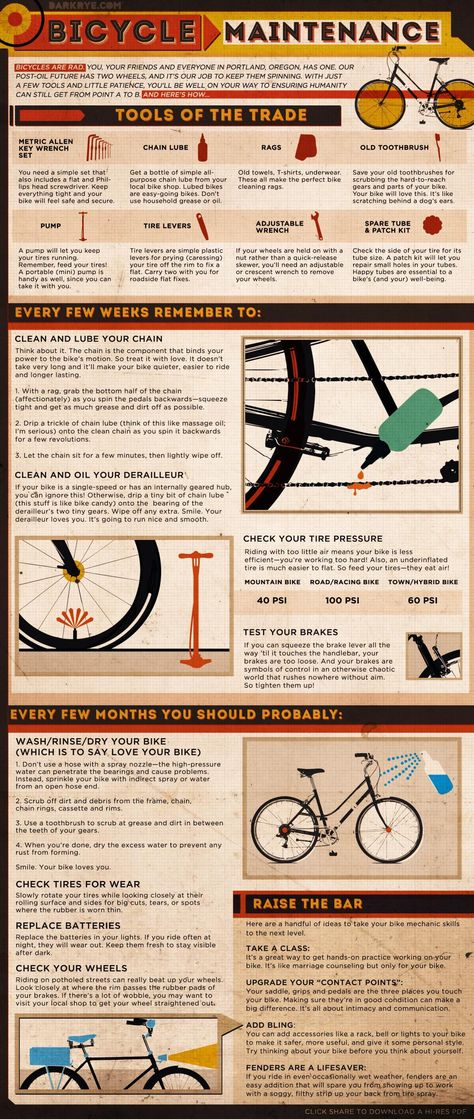Calculate Out-The-Door Price
close
With this easy test, a penny can buy you peace of mind when it comes to your tires and safety.
Place a penny head first into several tread grooves across the tire. If you always see the top of Lincoln’s head, your treads are shallow and worn. If this is the case, your tires need to be replaced.
If part of Lincoln’s head is always covered by the tread, you have more than 2/32 of an inch of tread depth remaining. This means you probably don’t need new tires.
When your tire treads are worn, your car may respond poorly in adverse weather conditions like rain and snow. With good treads, your car will grip the road better. Also, having insufficient tread is considered illegal in many states.
And finally, worn treads can make other parts of your car wear prematurely.
Potential Problem Areas:
When it’s time to change your tires, your Firestone Complete Auto Care dealer wants to make purchasing a new set as simple as possible. We have the best selection of quality tires to fit your vehicle, your budget and your driving style. From economy to ultra high performance tires - in the size you need from brands you trust, including our well-known Bridgestone and Firestone brands - you can find what you need right here.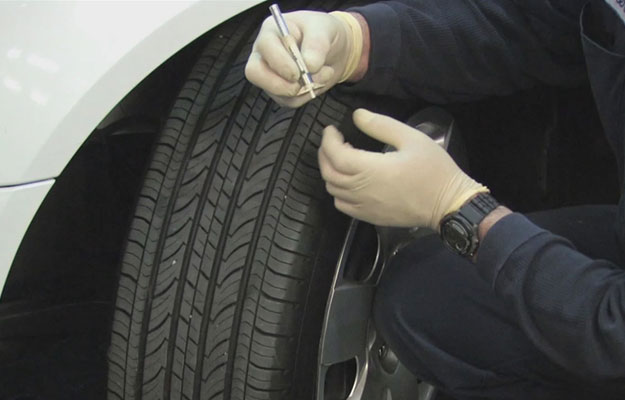
Make a selection from the following options:
Shop for Tires
Find a Store Near You
Schedule an Appointment
{{storeNumber}}
{{storeName}}
{{link-icon "Call Us" mobileCallLink null "call-cta"}} {{link-icon "Directions" directions "_blank" "directions-cta"}}
{{address}}
{{city}}, {{state}} {{zip}}
{{#if activeFlag}} {{#ifCond mystore "or" myPreferredStore}} {{#ifCond storeType 'eq' "TPL"}}
*Call store for appointment {{phone}}
{{else}} {{#if onlineAppointmentActiveFlag }}
{{#if myPreferredStore}}
{{else}}
*Call store for appointment {{phone}}
{{/if}} {{/ifCond}} {{else}} {{#ifCond storeType 'eq' "TPL"}}
*Call store for appointment {{phone}}
{{else}}
Schedule Appointment {{#if onlineAppointmentActiveFlag}} {{else}}
*Call store for appointment {{phone}}
{{/if}}
{{/ifCond}} {{/ifCond}} {{else}}
*Temporarily Closed Due To: {{temporarilyClosedReason}}
{{/if}} {{#if isMilitaryStore}}
*This location is on an active US military base. You may need military ID to access the location.
You may need military ID to access the location.
{{/if}}
By: Deanna Sclar and
Updated: 05-24-2021
From The Book: Auto Repair For Dummies, 2nd Edition
Explore Book Buy On Amazon
You should check your tires for wear at least once a month and before and after long trips. You check them to determine whether you need to buy new tires, have your wheels balanced, have your wheels aligned, or change your driving habits.
Underinflated tires wear out faster, create excessive heat, increase fuel consumption, and make your car harder to handle. Overinflated tires can “blow out” more easily, wear out faster, and make the vehicle unstable and unsafe to handle. And a new set of tires on wheels that are out of alignment can wear out completely in as little as one day of hard driving!
And a new set of tires on wheels that are out of alignment can wear out completely in as little as one day of hard driving!
What the signs of poor treadwear mean.
To determine what’s causing problems with your tires, try the following:Look for things embedded in each tire. Do you see nails, stones, or other debris embedded in the treads? Remove them. If you hear a hissing sound when you pull a nail, push the nail back in quickly and take the tire to be fixed. Tires with leaks should be patched by a professional.
Look at the sidewalls. Check for deeply scuffed or worn areas, bulges or bubbles, small slits, or holes. Do the tires fit evenly and snugly around the wheel rims?
Look at the treads. Most tires have built-in treadwear indicators. These bars of hard rubber are normally invisible but appear across treads that have been worn down to one-sixteenth of an inch of the surface of the tire (the legal limit in most states). If these indicators appear in two or three different places less than 120 degrees apart on the circumference of the tire, replace the tire.
If these indicators appear in two or three different places less than 120 degrees apart on the circumference of the tire, replace the tire.
It’s time for new tires when treadwear indicators appear.
If your tires don’t show these indicators and you think that they may be worn below legal tolerances, place a Lincoln penny head-down in the groove between the treads. If you can see the top of Lincoln’s head, your tire probably needs to be replaced.
To measure treadwear more precisely, place a thin ruler into the tread and measure the distance from the base of the tread to the surface. It should be more than one-sixteenth of an inch deep. (If your front tires are more worn than your rear ones and show abnormal wear patterns, you probably need to have your wheels aligned.)
Sometimes one-sixteenth inch of tread isn’t enough to keep you safe. If you live in a rainy area, measure the depth of your treads with a quarter rather than a penny, using Washington’s hair to see if your tires have at least two-sixteenths of an inch of tread remaining.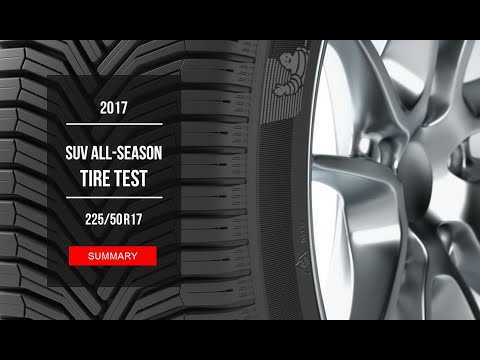
Pay attention to leaks. If you keep losing air in your tires, have your local service station check them for leaks. Sometimes an ill-fitting rim causes a leak. The service facility has a machine that can fix this problem easily.
| Clue | Culprit | Remedy |
|---|---|---|
| Both edges worn | Underinflation | Add more air and check for leaks |
| Center treads worn | Overinflation | Let air out to manufacturer’s specifications |
| One-sided wear | Poor alignment | Have wheels aligned |
| Treads worn unevenly, with bald spots, cups, or scallops | Wheel imbalance and/or poor alignment | Have wheels balanced and aligned |
| Erratically spaced bald spots | Wheel imbalance or worn shocks | Have wheels balanced or replace shocks |
| Only edges of front tires worn | Taking curves too fast | Slow down! |
| Saw-toothed wear pattern | Poor alignment | Have wheels aligned |
| Whining, thumping, and other weird noises | Poor alignment or worn tires or shocks | Have wheels aligned or buy new tires or shocks |
| Squealing on curves | Poor alignment or underinflation | Check wear on treads and act accordingly |
If your tires appear to be low, check the pressure and note the amount that they’re underinflated.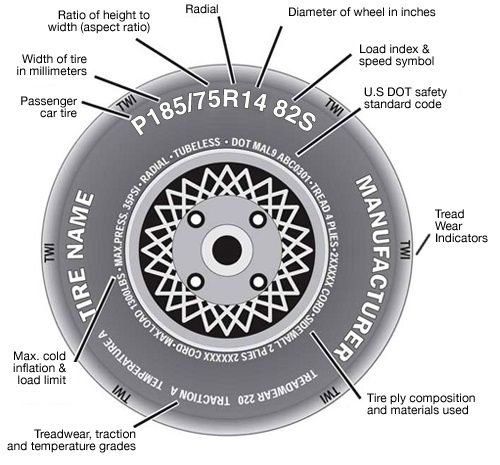 Then drive to a local gas station and add air. It’s easy, but be sure to bring some change (usually quarters) with you for the air dispenser. (Forget about things being “as free as air” — at many stations it isn’t!)
Then drive to a local gas station and add air. It’s easy, but be sure to bring some change (usually quarters) with you for the air dispenser. (Forget about things being “as free as air” — at many stations it isn’t!)
Park your vehicle by the air dispenser.
You will need to reach all four tires with the air hose.
Remove the cap from the tire valve on the first tire.
Use your tire gauge to check the air pressure in the tire.
Air hose gauges at many gas stations are inaccurate.
Checking your tire pressure
The pressure will have increased because driving causes the tires to heat up and the air inside them to expand. To avoid overinflating the tire, no matter what the second reading indicates, you should only add the same amount of air that the tire lacked before you drove it to the station.
Use the air hose to add air in short bursts.
Check the pressure after each time with your tire gauge.
If you add too much air, let some out by pressing the pin on the tire valve with the back of the air hose nozzle or with the little knob on the back of the rounded end of the tire gauge.
Keep checking the pressure until you get it right.
Don’t get discouraged if you have to keep adjusting the air pressure. No one hits it on the head the first time!
Deanna Sclar is an acclaimed auto repair expert. She has appeared on hundreds of radio and TV shows, including NBC's Today show and the NBCNightly News. Sclar lectures internationally on the ecological impact of vehicles and is active in promoting residential solar energy programs. Sclar is also the author of Buying a Car For Dummies.
Sclar is also the author of Buying a Car For Dummies.
In fact, the average life of any tire is 5-7 years, but a lot depends on how the owner treats his car. Aggressive driving, improper seasonal tire storage, unrepaired suspension/balancing problems, incorrect pressure and other errors can significantly shorten tire life. But worn tires can be a serious problem on the road: an increased risk of uncontrolled skidding, hydroplaning, even accidents is the price that drivers and passengers have to pay for using old tires.
Each manufacturer indicates the so-called wear index on the tire profile, which most often looks like the inscription “Treadwear 100” and means a maximum of 48,000 km on a standard road surface (polygon).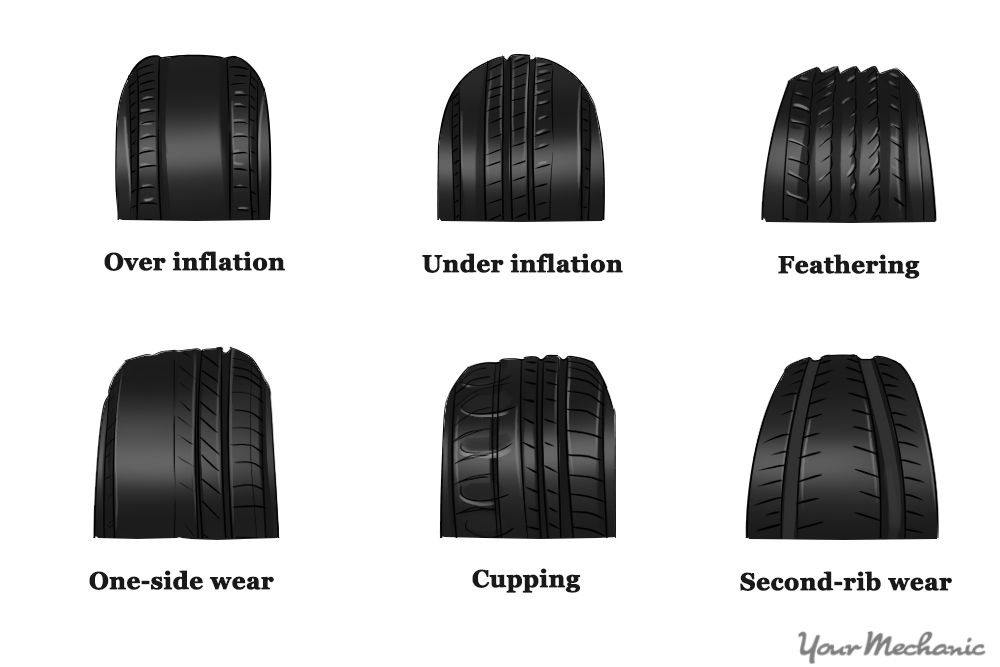 In a real environment and often not the most ideal roads, this number actually needs to be divided by 1.5 - we get 36,000 km.
In a real environment and often not the most ideal roads, this number actually needs to be divided by 1.5 - we get 36,000 km.
By analogy, if the wear resistance index is 150, then this means “factory” 72 thousand km, 200 - 96 thousand km., and so on.
What are the dangers of worn tires on the road:
adhesion to the roadway deteriorates, which leads to an increased likelihood of skidding, accidents, hydroplaning in case of rainy weather;
reduced cross-country ability in off-road conditions;
increases the risk of a tire puncture while driving.
It is also worth remembering that the issue of tire wear is regulated by traffic rules, and you can get a fine for using “bald” rubber. Knowing what maximum tire wear is acceptable, this is easy to avoid: 1.5-2 mm for summer, and 4-5 mm for winter (a more accurate figure is indicated by the manufacturer).
1. According to the wear indicator on the tire. To find this indicator, you need to inspect the side of the tire and find one of the markings: a triangle, a company logo, a snowflake, or the abbreviation TWI. If the tread has worn down to this indicator, it means that the tire needs to be disposed of urgently.
According to the wear indicator on the tire. To find this indicator, you need to inspect the side of the tire and find one of the markings: a triangle, a company logo, a snowflake, or the abbreviation TWI. If the tread has worn down to this indicator, it means that the tire needs to be disposed of urgently.
2. Many people in the old fashioned way prefer to use a 10-kopeck coin. Insert it into the tread with the inscription "10 kopecks" towards you, and if it is visible, the wear level is too high, you need to replace the tire. This method is convenient, but not entirely accurate: by measuring wear in different parts of the tire in this way, it will be difficult to estimate its unevenness by eye, and this is also an extremely important indicator.
3. It is optimal to use a special gauge, depth ruler or caliper for these purposes. This will allow you to measure the wear of the tread in different parts of the tire with an accuracy of up to a millimeter and understand if there is uneven wear.
If measurements show different results in different parts of the tread, it is important to determine exactly how your tires wear in order to understand where and what the operating error is.
If the tread wears more on the sides and the center wears off less, this means that the tire pressure is insufficient and the contact patch with the road is not correct. This leads not only to poor vehicle stability, but also to increased fuel consumption.
If the tread is worn down the middle but the sidewalls are fine, then your tires are overinflated. Sometimes this is done intentionally in order to save fuel, but in this case, the tires will still have to be changed ahead of schedule.
There is also the possibility of increased wear on the inside or outside of the tread - this indicates an incorrect camber. A visual table with wear options and their causes:
Cracks on the sides of tires can indicate frequent off-road driving, improper storage, low-quality rubber or long service life, as well as incorrect tire pressure.
Bulges or "hernias" on the sides of the tires appear as a result of the side part hitting hard obstacles. Tires with such damage are not recommended.
Dents on the tread indicate insufficient depreciation and unadjusted camber. Having found such damage, it is necessary to drive the car to the service and make sure that the suspension is in good condition.
Individual wear spots on the tread indicate aggressive driving / braking, skidding with wheel locks, or prolonged parking of the car in one position.
Most often, this is required for the sale and purchase of used tires in order to orient the buyer in the degree of their wear. Many sellers give this figure at random, but this method has nothing to do with the actual assessment of the degree of tire wear. It is also important to understand that a conditional 50% wear for a summer tire is an acceptable value, while 50% wear of a winter tire tread is a sign that the tire cannot be used. Therefore, it is important to know how to accurately determine the percentage of tire wear so as not to get into an unpleasant situation.
Many people divide the actual tread height by the height of the same, but new tire, and get a certain percentage of wear. This would be correct, if not for one BUT: we cannot physically erase the tread to zero, and the law prohibits the use of tires with a tread below the permitted values.
You can calculate actual tire wear by dividing the difference between the new tire height and the actual tire height by the difference between the new tire tread height and the minimum possible tread height for that tire, and then multiplying this number by 100.
If it is impossible to find out the height of the same, but with a new tire, use the average values of your tire type:
| Tire type | Average tread height at start of use |
| Winter tires with Scandinavian tread | 10 mm |
| Winter with regular or asymmetric tread | 9 mm |
| High-speed winter | 7 mm |
| Summer tires with classic tread | 8 mm |
| Summer speed | 7 mm |
You can check summer tires for wear a little less often than winter tires, since in summer the tread depth is not so important for patency.
If you have assessed the condition of your tires on all of the above factors and realized that the tires are worn out, be sure to replace them with new ones as soon as possible.
The task of calculating the residual life of a tire can arise both when assessing the condition of one's own wheels, and when buying used rubber. In addition to indirect signs, the residual tread height becomes such a criterion. But it can also be calculated based on subjective assumptions, which is what sellers usually do.
Contents of the article:
here and the unknown with the initial depth of the Age and uncertainty with a maximum allowable residual. The question requires objectivity.
The question requires objectivity.
The suitability of tires for further use is determined by their ability to meet safety standards, and is set by the manufacturer using wear indicators or numerical values.
In the absence of such, one should be guided by the requirements of the traffic rules, where the minimum allowable tread depth is set, depending on the type and purpose of tires.
Both do not take into account all the features of wear, therefore, taking care of your own safety, you need to approach the issue as objectively as possible, and not be content with formal criteria.
See also: What is wheel bolt pattern and how to measure it
So, for example, if the tread remains within the allowable millimeters, but the terrain is already severely distorted due to uneven wear, the rubber has lost its properties or the initial height was more than typical, then the tire must be sent to the scrap, although according to numerical indicators it meets the standards.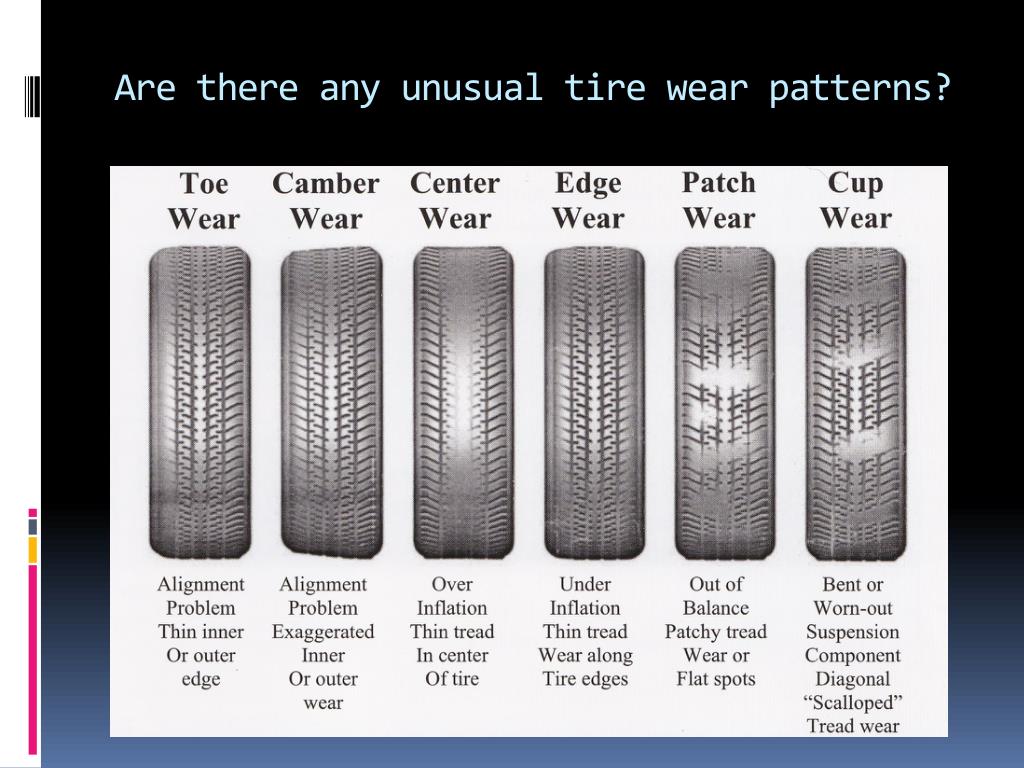
Most of the assessment methods are available to the average user, although not all of them.
A lot can be assessed visually. For example, the color of rubber loses saturation over time, tires become characteristically whitish. This is a good indication that aging has occurred due to oxidation of the tire material.
Mechanical damage is also visible, both natural in the form of age-related cracks and delamination, and artificial, traces of numerous repairs, cord exposure due to cuts, profile bulges under pressure (bumps).
Related article: Spikes or Velcro, which tires are better to use in winter
Very noticeable uneven tread wear in the form of a saw or bald spots. Such a wheel is dangerous when braking.
To estimate the actual residual value, you need to know the original tread value, as well as the minimum allowable for a particular tire model.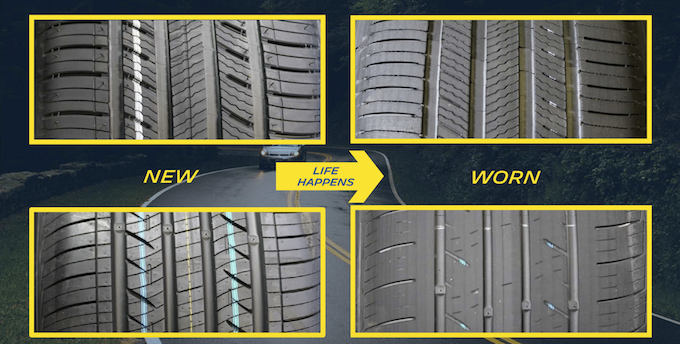 A big mistake that sellers most often deliberately make is to consider percentages based on absolute depth.
A big mistake that sellers most often deliberately make is to consider percentages based on absolute depth.
Do not use the tire until it is completely worn out. Moreover, based on the purpose, rubber can completely lose its properties even with a sufficiently deep pattern.
This applies to winter, mud and all season tyres. They must effectively remove the soft component of the road surface from the contact zone, which is possible only with a sufficiently deep tread.
This is the most convenient way to determine tire wear by the manufacturer. In the rubber of the tread, recesses are made in the form of numbers, which disappear as the rubber wears out. The largest of the remaining ones determines the resource height of the relief.
Other indications are also possible, all of them are simple and most intuitive.
Interesting: What and how to glue the molding on the car door
Up to the use by some manufacturers of color indication, when rubber of a different shade is embedded in the depth of the tread. A worn treadmill will then change color to contrast with the rest of the surface.
A worn treadmill will then change color to contrast with the rest of the surface.
Although it is almost impossible to find modern tires without wear indicators at all, the old methods continue to work. Between the checkers or tracks of the tread, you can place a caliper depth gauge, which will show the remaining depth in millimeters.
All that remains is to subtract the minimum allowable value from the resulting number. In the absence of a caliper, you can use a ruler, or even just a coin.
Wheel alignment significantly affects rubber wear, up to complete destruction of the tread for a short run with a strong deviation from the norm.
A distorted toe value results in the formation of a characteristic "saw" on the tracks, which is clearly visible when looking along them. The plane of rotation of the wheel does not coincide with the direction of movement of the car, which is why the tread constantly slips in the contact zone, this causes sawtooth wear.